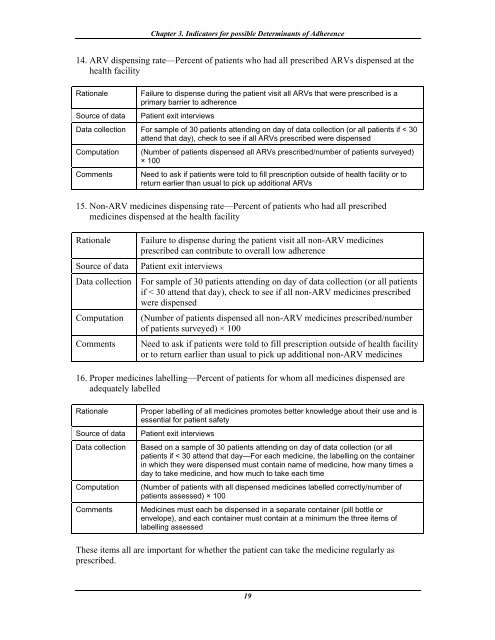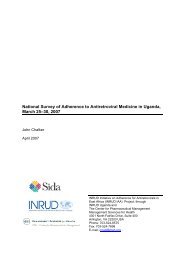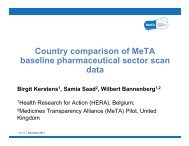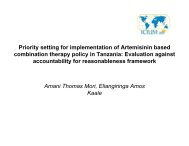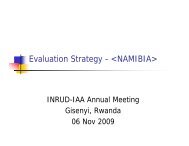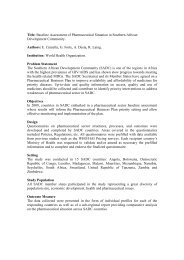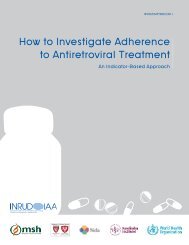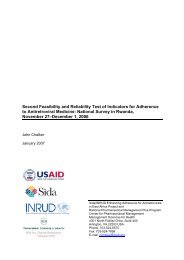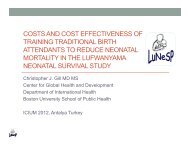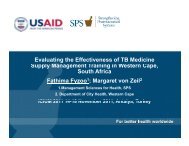How to investigate Adherence to Antiretroviral Treatment ... - INRUD
How to investigate Adherence to Antiretroviral Treatment ... - INRUD
How to investigate Adherence to Antiretroviral Treatment ... - INRUD
Create successful ePaper yourself
Turn your PDF publications into a flip-book with our unique Google optimized e-Paper software.
Chapter 3. Indica<strong>to</strong>rs for possible Determinants of <strong>Adherence</strong><br />
14. ARV dispensing rate—Percent of patients who had all prescribed ARVs dispensed at the<br />
health facility<br />
Rationale<br />
Source of data<br />
Failure <strong>to</strong> dispense during the patient visit all ARVs that were prescribed is a<br />
primary barrier <strong>to</strong> adherence<br />
Patient exit interviews<br />
Data collection For sample of 30 patients attending on day of data collection (or all patients if < 30<br />
attend that day), check <strong>to</strong> see if all ARVs prescribed were dispensed<br />
Computation<br />
Comments<br />
(Number of patients dispensed all ARVs prescribed/number of patients surveyed)<br />
× 100<br />
Need <strong>to</strong> ask if patients were <strong>to</strong>ld <strong>to</strong> fill prescription outside of health facility or <strong>to</strong><br />
return earlier than usual <strong>to</strong> pick up additional ARVs<br />
15. Non-ARV medicines dispensing rate—Percent of patients who had all prescribed<br />
medicines dispensed at the health facility<br />
Rationale<br />
Source of data<br />
Data collection<br />
Computation<br />
Comments<br />
Failure <strong>to</strong> dispense during the patient visit all non-ARV medicines<br />
prescribed can contribute <strong>to</strong> overall low adherence<br />
Patient exit interviews<br />
For sample of 30 patients attending on day of data collection (or all patients<br />
if < 30 attend that day), check <strong>to</strong> see if all non-ARV medicines prescribed<br />
were dispensed<br />
(Number of patients dispensed all non-ARV medicines prescribed/number<br />
of patients surveyed) × 100<br />
Need <strong>to</strong> ask if patients were <strong>to</strong>ld <strong>to</strong> fill prescription outside of health facility<br />
or <strong>to</strong> return earlier than usual <strong>to</strong> pick up additional non-ARV medicines<br />
16. Proper medicines labelling—Percent of patients for whom all medicines dispensed are<br />
adequately labelled<br />
Rationale<br />
Source of data<br />
Data collection<br />
Computation<br />
Comments<br />
Proper labelling of all medicines promotes better knowledge about their use and is<br />
essential for patient safety<br />
Patient exit interviews<br />
Based on a sample of 30 patients attending on day of data collection (or all<br />
patients if < 30 attend that day—For each medicine, the labelling on the container<br />
in which they were dispensed must contain name of medicine, how many times a<br />
day <strong>to</strong> take medicine, and how much <strong>to</strong> take each time<br />
(Number of patients with all dispensed medicines labelled correctly/number of<br />
patients assessed) × 100<br />
Medicines must each be dispensed in a separate container (pill bottle or<br />
envelope), and each container must contain at a minimum the three items of<br />
labelling assessed<br />
These items all are important for whether the patient can take the medicine regularly as<br />
prescribed.<br />
19


